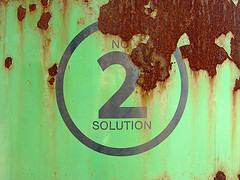
Debunking The Myth of the 2 Minute Rule
Mondays are productivity days at SimpleProductivity blog.
One of the standard pieces of productivity advice is “if it will take you less than two minutes to do the task, do it now.” Unfortunately, this can actually be counter-productive. Today we will look at the additional conditions you need to assess before applying the 2 minute rule.
The 2 Minute Rule
The most popular source of the 2 Minute Rule is from Getting Things Done*.
David Allen has said “I have a two-minute rule that says: If you determine an action can be done in two minutes, you actually should do it right then because it’ll take longer to organize it and review it than it would be to actually finish it the first time you notice it.
As a generalization, it makes a good point: if you can do the action faster than you can enter it into the system, it makes sense to do the action. After all, from a theoretical standpoint, it saves time.
Therein lies the building of a myth. Let’s bust it.
Why It Is A Myth
Plain and simple, the 2 minute rule is good only if it doesn’t cause a greater interruption in your current workflow. Let’s look at two times when it would interrupt.
Location, Location, Location
If you have to change physical locations, chances are it is going to disrupt what you were doing. For instance, you are working on paying bills at your computer, and you realize you need toilet paper in the bathroom. Even if it takes you less than two minutes to put the toilet paper in the bathroom and get back to your desk, you have now changed your location twice. You have to get up, put the paper in the bathroom, then go back and figure out where you were before you were interrupted.
Changing physical locations can cause you to have to rethink what you were doing before it happened, and that takes time.
The Value Of A Train Of Thought
If you are deep in an intricate task and you have a thought of a task that is outside that task, it will cause an interruption in your workflow. For example, you are working on entering receipts for your taxes and you find an income statement mixed in. Even if it is the previous screen back, and it will take ten seconds to enter, you will have lost your place in the receipts, and you will spend more time figuring out what was already entered.
Changing train of thought takes time, because you have to figure out where you were before you left off.
Modifying The 2 Minute Rule
The 2 Minute Rule is a good rule to follow, IF you don’t have to change physical locations, or you don’t have to leave the task you are doing un-done.
In both cases, it is better to jot the task down and finish what you are currently doing, then do the tasks that came to your attention.
By giving yourself the chance to finish what you are focused on, you are minimizing both mental and physical switch time, and are therefore more productive.
Conclusion
The 2 Minute rule is a good one, but only within the context of your current physical location or task. Doing things as they occur to you, even if they are short duration, leads to fractured attention and wasted time.
Photo by Hryck.. Licensed under Creative Commons.





2 Comments
Jesse
just found the same limitations sometimes. for example I’m in the basement and I find something that needs to go to the bedroom or the kitchen or the living room. if there are several of those items that are find if I took 2 minutes to take each one to its proper place, i would be extremely unproductive. better for me to agregate those items into piles and then take them all at once. Same can be said for some micro todo items. I find it better to bunch of the tiny micro related tasks together rather than deal with them one by one. Davids two-minute rule was ideal when we all lived in a day runner, filofax paper inbox, don’t-touch-anything-more-than-once paper world.
LJ Earnest
Loved your summary of David’s two minute rule! 🙂